Newsletter August 2018
WELCOME - It gives me enormous pleasure to welcome you to our second newsletter of 2018.At Christmas I thanked you all for your support and enthusiasm as I looked back over our achievements in 2017. I am pleased to report that so far this year is looking reasonably good, although most birds are starting to breed later than usual. Our focus in the spring and summer moves away from box building and preparation to the fundamentals of monitoring, ringing and reporting on nest activity.
It’s been a poor year for Tawnies with only eight fledglings ringed. We're just beginning to inspect the Barn Owl and Kestrel boxes and they are looking good. The key to this is the presence of a plentiful food supply – lots of voles and field mice. If there is plenty of food then the birds will happily reproduce – so fingers crossed. Our nest boxes are important too though. With over two thirds of the national Barn Owl population now nesting in man-made boxes you'll see that our work, and the support of people like you, is critical.
One of the pleasures of being in the group is to meet our landowners and enthusiasts and to be able to show them the fruits of their support. We've made an effort this spring to share the "pleasures" of our trusty Defender and take assorted lucky people on a bumpy ride to watch as we inspect and ring the birds; something we'll keep on trying to do during the summer.
In the meantime if you want to keep in touch then just email us on info@giveahoot.org.uk and/or follow us on our twitter account (@Borg_Owl_Raptor). Keep an eye out for us this summer. We'll be at several events including the Winslow Show on August 27th and the Bucks County Show on August 30th so why not come along and say hello.
Once again thanks for your support and here's to a great summer!!!
Alex Matthews (Chairman)
Once again thanks for your support and here's to a great summer!!!
Alex Matthews (Chairman)

Social Media : Twitter and the Website
Our website has been up and running for two years and continues to provide our supporters with information on the services we provide and also what they, as individuals, can do to help and support us in our work. An integral part of this is the friendly and interactive nature of the site, enabling supporters to contact us directly using the web site or, as in the case of “Friends of BORG”, register and support us via the links provided on the website.
The BORG Twitter feed (@Borg_Owl_Raptor) has gone from strength to strength over the past twelve months.
The Twitter feed continues to grow and add to the work the group does, informing the wider public of our activities. It’s been almost a year since I set up the twitter feed and Des linked it to the website and in that time we’ve gained over 200 followers, allowing us to interact with other conservation organisations as well as experts in the field that we work in.
In the last 28 days our tweets have earned over 19,000 impressions.
The Twitter feed continues to grow and add to the work the group does, informing the wider public of our activities. It’s been almost a year since I set up the twitter feed and Des linked it to the website and in that time we’ve gained over 200 followers, allowing us to interact with other conservation organisations as well as experts in the field that we work in.
In the last 28 days our tweets have earned over 19,000 impressions.
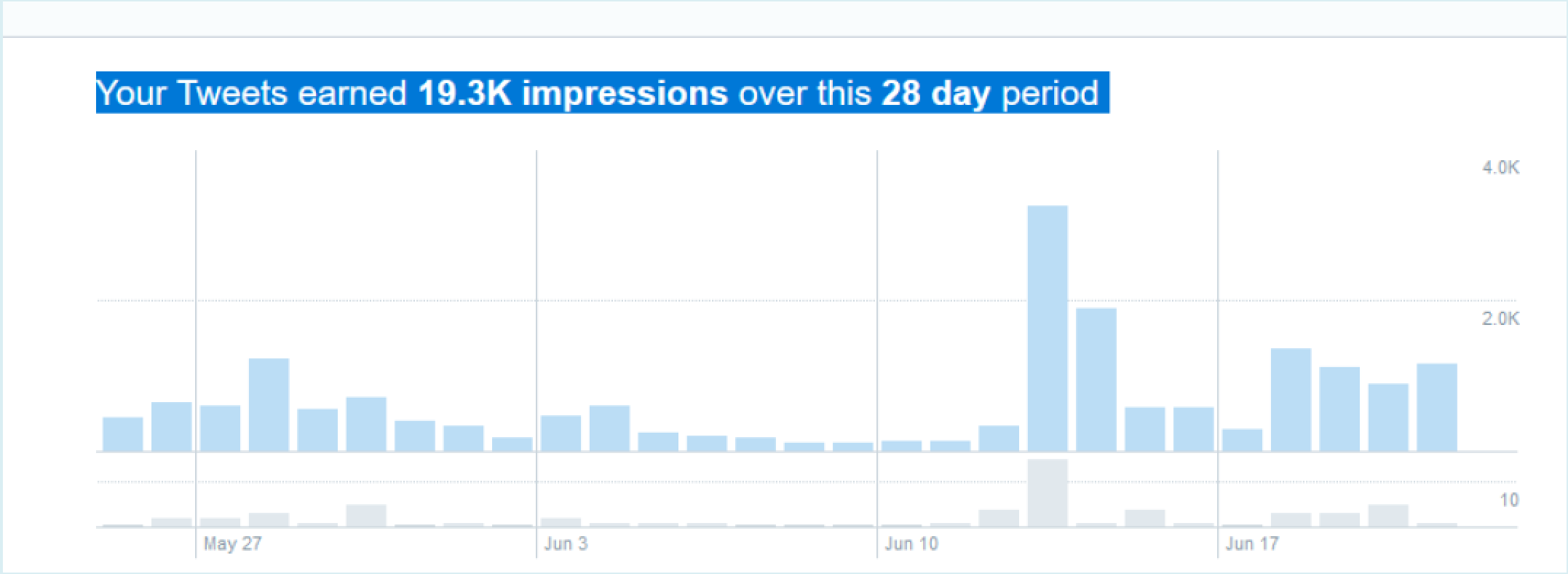
We’ve linked with local groups such as Lindengate and Tiggywinkles, as well as casting our net further afield with UK Little Owl specialist Dr Emily Joachim, who has been studying Little Owl population in the UK for over a decade. We plan to meet Emily in the autumn when the hectic monitoring season has ended. The story of the Kestrel family, documented so well by Roy Gray, was also very popular.
The holy grail for the Twitter feed would be to gain a wildlife celebrity, to broaden our appeal and gain further followers. I’ve managed to get respected wildlife filmmaker Richard Taylor-Jones to follow us and will continue to add other famous followers.
With monitoring in full swing, I expect interest to continue to build as I add photos of cute fluffy chicks - Mark Ritson
The holy grail for the Twitter feed would be to gain a wildlife celebrity, to broaden our appeal and gain further followers. I’ve managed to get respected wildlife filmmaker Richard Taylor-Jones to follow us and will continue to add other famous followers.
With monitoring in full swing, I expect interest to continue to build as I add photos of cute fluffy chicks - Mark Ritson
Monitoring News for 2018
If you are receiving this newsletter then perhaps you have one or more of our boxes on your property, and are eagerly waiting to find out if you have any birds nesting in them this year. So, here’s the situation so far.Our group is normally made up of 12 experienced volunteers, split into 6 monitoring groups, each with their own specific area within the county of Buckinghamshire. However, this season that is not the case! Unfortunately, we are four active volunteers down, due to maternity leave, recovering from surgery and work commitments, and this in turn means we are two groups short. We have therefore had to prioritise our monitoring in order to work effectively.
THE ACTION PLAN: All our active boxes from previous years have been given a colour code. Any box which has had owls or kestrels nesting in them in the previous 2 years is colour coded GREEN. Any box which has had a nest in it 3 years ago, or has had signs of birds in them but not nesting is AMBER, all others are RED.
What this means is that because of our shortage of experienced volunteers we are concentrating on GREEN boxes first, and AMBER next; RED boxes may not get a visit unless circumstances improve.
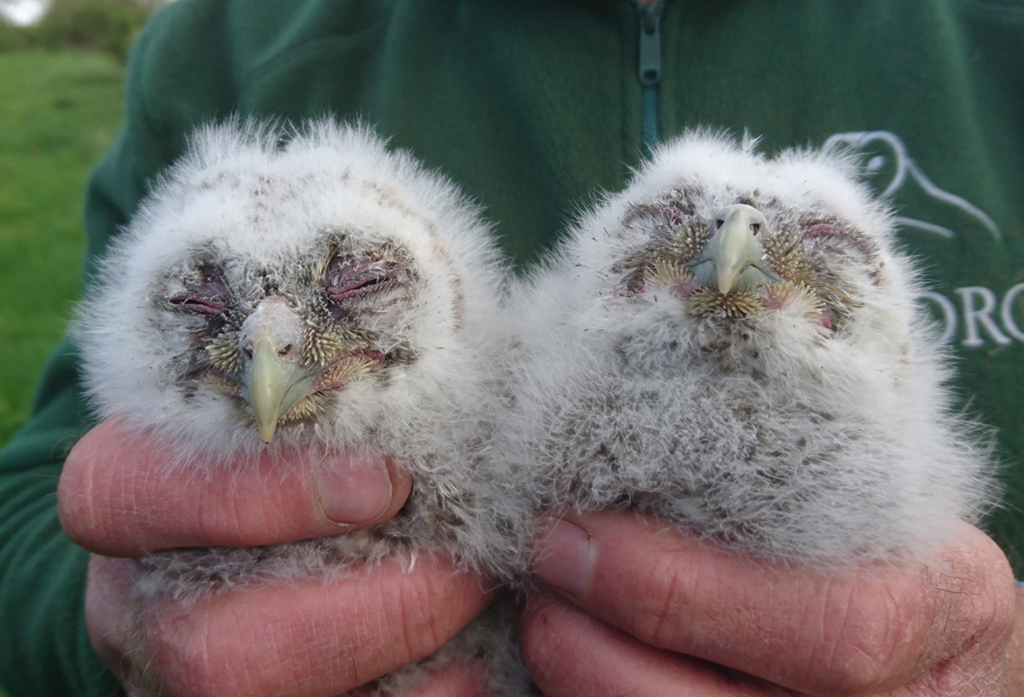
The season so far is proving to be very late, probably due to the cold wet winter, and also because we believe that the primary food for all owls (the short tailed/field vole) is in decline. This creature represents 80% of most owls’ diet! This decline is a natural event that follows a three to five year cycle of boom and bust. The past two seasons have been very good, so a correction is due at any time!
TAWNY OWLS - these are the first to nest and we can report that we have only ringed 8 chicks so far, compared with 22 last year. Something odd is happening, but what?
TAWNY OWLS - these are the first to nest and we can report that we have only ringed 8 chicks so far, compared with 22 last year. Something odd is happening, but what?
KESTRELS – our focus now is on Kestrels and it seems that most are late starting to nest. So far we have ringed about 12 chicks, but there is a long way to go with plenty of eggs and new-born chicks in the nest. However, it remains to be seen how many survive to fledge.
Incidentally, we have seen lots of evidence that kestrels are taking small birds for food, perhaps another sign of a shortage of voles?
Incidentally, we have seen lots of evidence that kestrels are taking small birds for food, perhaps another sign of a shortage of voles?
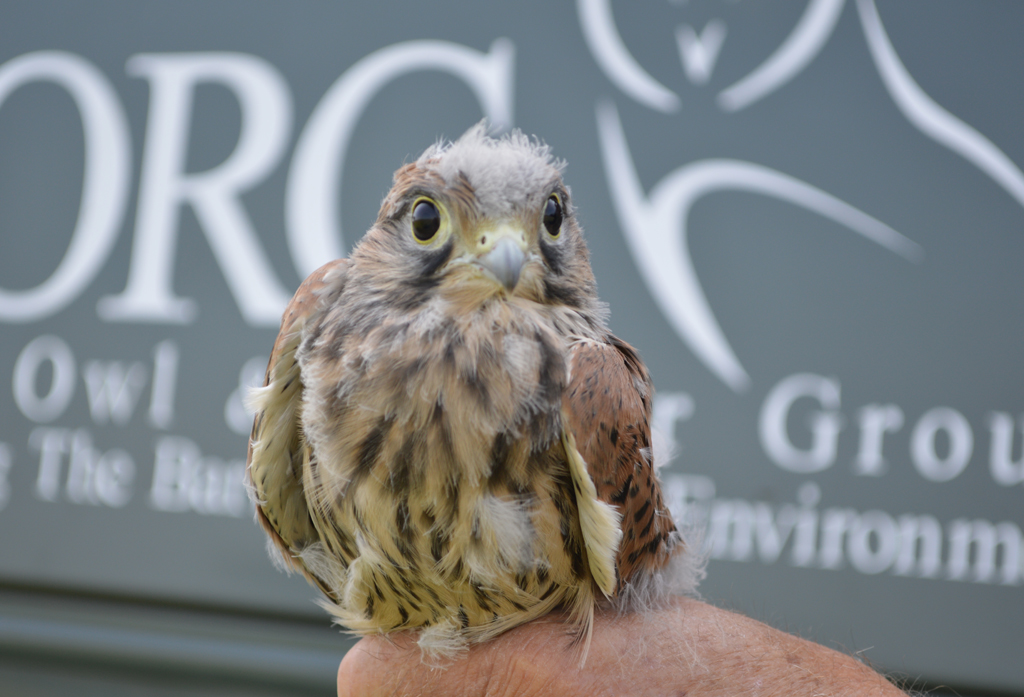
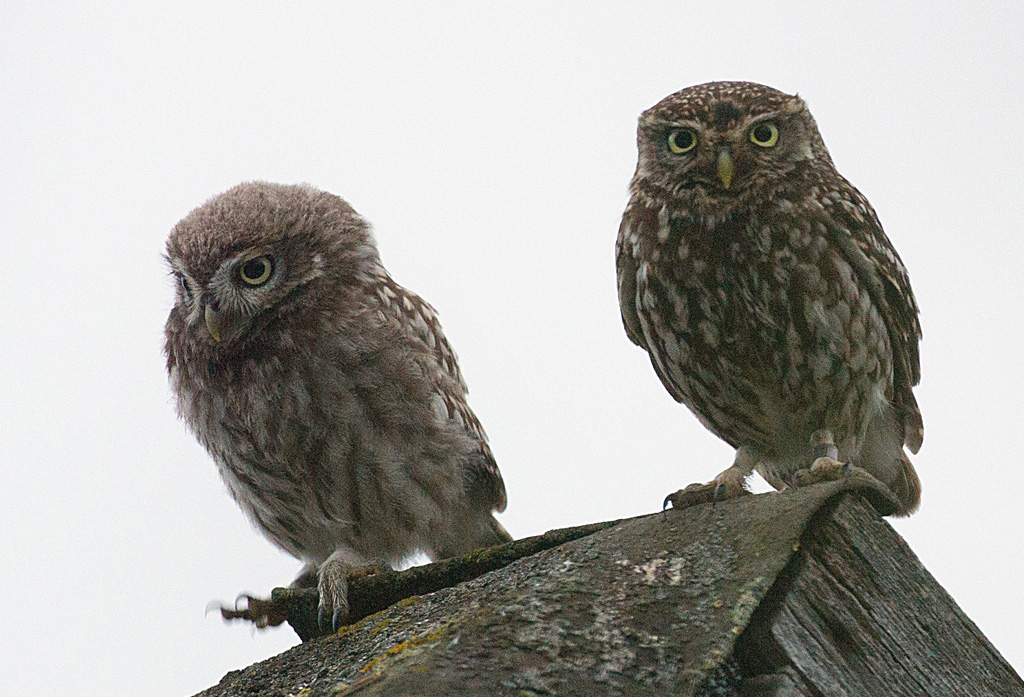
LITTLE OWLS – these birds are really suffering in Bucks and across the country. Last winter saw us installing several new Little Owl boxes in the hope that they would encourage the owls to nest this year. Our aim is to further increase the number of boxes this year, so fingers crossed for 2019.
The numbers within our remit have increased slightly this year. However, we have still only ringed 8 in total! Although, at one site, despite two new, tailor made homes the local owls still used a natural nest hole which we didn’t find until after the youngsters had fledged.
The numbers within our remit have increased slightly this year. However, we have still only ringed 8 in total! Although, at one site, despite two new, tailor made homes the local owls still used a natural nest hole which we didn’t find until after the youngsters had fledged.
BARN OWLS - in a normal year these owls start laying around 21st April, but to date we have only 4 pairs with eggs and 4 with small chicks. We also have about 20 pairs in boxes, but with no eggs. The birds are paired-up and waiting to get into condition before mating, laying and rearing. They seem to want to breed, but as yet may not be confident that there is sufficient food to support themselves, let alone a brood of hungry offspring.
Barn Owls have a very long breeding season, so time may yet be on their side - watch this space we will update you in our next newsletter.
Barn Owls have a very long breeding season, so time may yet be on their side - watch this space we will update you in our next newsletter.
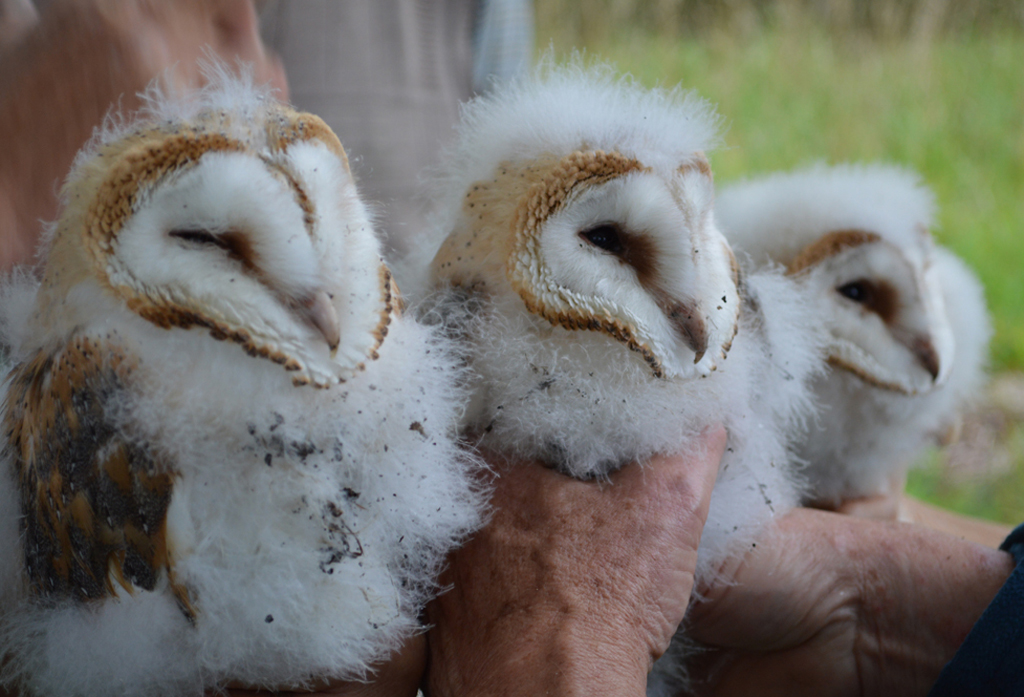
Landowners: We may have already visited you, if not we hope to be visiting you soon.
However, if we do not then please forgive us, as we have exceptional circumstances to contend with this year - Norman Shepherd
MANY THANKS FOR YOUR ONGOING SUPPORT.
However, if we do not then please forgive us, as we have exceptional circumstances to contend with this year - Norman Shepherd
MANY THANKS FOR YOUR ONGOING SUPPORT.
Licensing – What is the Schedule 1 Licence?
Barn Owls are just one of the relatively uncommon species that are given special protection during the breeding season. The Wildlife and Countryside Act 1981 makes it a criminal offence to “intentionally or recklessly” disturb the species listed under Schedule 1 of the Act during the breeding season, with fines of up to £5000 and/or a prison sentence of 6 months.There are 88 species on the Schedule 1 list for England, Wales and Scotland with a different set of species in Eire and Northern Ireland; they include Peregrine, Bee Eater, Hen Harrier, Kingfisher, Red Kite, Cetti’s Warbler, Goshawk, Hobby and Barn Owl. The full jncc.defra list can be found HERE
Licences to disturb are given because monitoring nests and ringing the birds is important for conservation. The British Trust for Ornithology (BTO) issues us a disturbance permit for ringing and nest recording on behalf of Natural England. We refer to this as our “Schedule 1 Licence” because it gives us the necessary permission to approach the nest site of a bird on the Schedule 1 list. Not just any bird – every year, before the season starts, we must apply for a licence to cover a particular species and a particular area. Licences are only issued to people who have a proven record of working with their chosen species and have sufficient experience to monitor the nests without risk of excessive disturbance. The holder of the licence can name other people on the licence (known as “accredited agents”), all of whom will be checked by the BTO and have to declare that they have never had any wildlife crime convictions.
The main priority remains to get information for conservation purposes while keeping disturbance to a minimum. An agent can have a couple of helpers to speed things up and reduce the time spent at the nest. A limited amount of photography is permitted as a record of the nest contents or the ringing process but it must never interfere with the activity or be the purpose of the visit.
[To photograph Schedule 1 species at the nest you need a specific photography licence. These are issued by Natural England on a strict quota system, and only to those experienced photographers who can demonstrate not only their knowledge of the breeding ecology of the species concerned but also the necessary photographic skills and fieldcraft to enable them to undertake nest photography without causing undue disturbance to the birds.]
At the end of the season we must send in a report on every nest box we check before we can apply for the following year’s licence. We have to report on the number of eggs and/or chicks; the ring numbers of any birds ringed; whether there were adults present; if the box was used as a roost site only and also if there were no birds present where they have been known to nest before. This way the BTO can monitor the breeding success and fortunes of our birds and raise alerts and warnings of any problems - Lynne Lambert
Some interesting stories from this year
We have had several interesting, some sad, ringing related stories from this year:A Barn Owl chick that had been ringed at Shalstone on 6th July 2017 was then found dead on the 4th March 2018 in a barn near Winchester, almost exactly 100km away from where it had been born.
Another Barn Owl chick had also moved a surprisingly long distance; this chick was ringed on the 17th June 2017 in Newton Longville, and was found on 8th March 2018 by the side of a road in Oadby, Leicester with a broken wing - a journey of 76km.
Kestrels too seem to be travelling long distances; we had one report of a bird, ringed on 4th July 2016 at Meadle Farm Shop in Bucks, which was found dead in a barn in Clanfield, Oxfordshire on 3rd March 2018 – a distance of 52km!
It goes to show that Barn Owls and Kestrels are capable of moving quite long distances to find a suitable territory of their own.
Some more interesting stories from this year...
Casualties, recovery and re-homing; During the spell of bad weather late last year, I got a call from a local dog-walker asking for help as she had spotted an injured Barn Owl. So after grabbing a coat, a towel and a cardboard box I set off to help retrieve the injured bird.
On returning to the site we spotted the bird on the other side of a drainage ditch, hopping along the ground. After negotiating the ditch and taking a wide berth around the owl, a young female, I managed to catch it, using the towel, but not before being skewered by a talon!
She was quite thin and very cold (there was snow on the ground at the time) and appeared to have one small injury to her upper wing joint. Once safely ensconced in the box, I took her home and put her next to the kitchen radiator to warm up, while I made arrangements to take her to Tiggywinkles Wildlife Hospital. On arrival at Tiggy’s she was logged in by the on-call nurse, Katie, who also happens to be a fellow BORG volunteer.
In early February, after several weeks’ treatment and recuperation the owl, together with a male - also a recovering inmate from Tiggy’s – was released into a box near the site of the initial recovery. Using hidden trail cameras and long distance observation I could see that the owls were doing OK and had stayed in the area. Neither was ringed when caught and, as casualties in a captive environment, could not be ringed prior to release. However, after a week or so I returned with other volunteers to ring the birds, but unfortunately they were nowhere to be found!
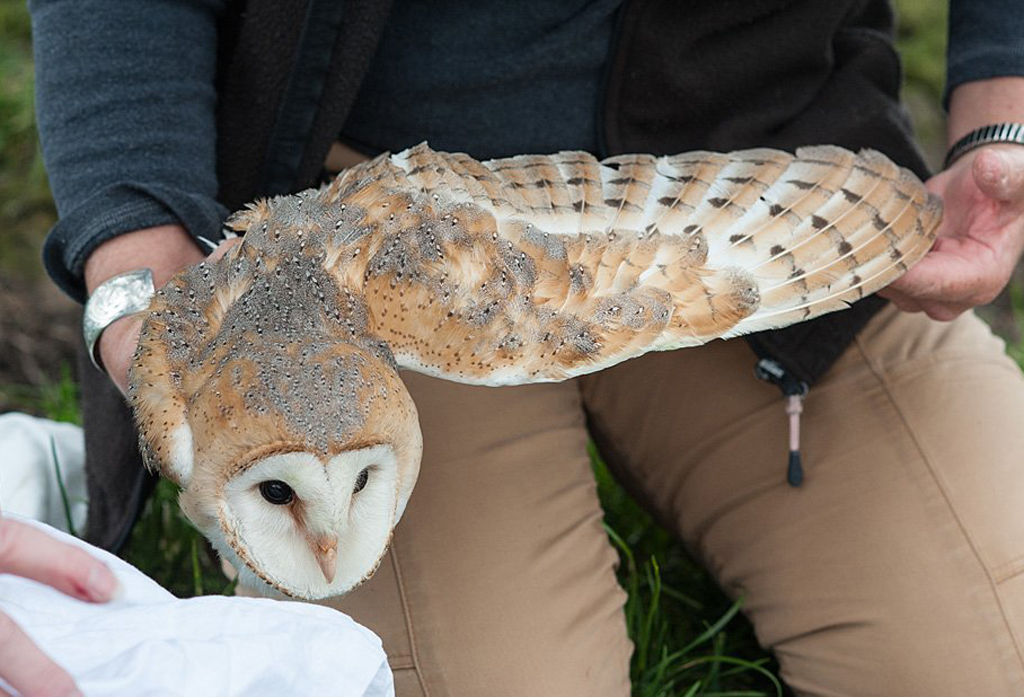
Then in early May, as part of the usual monitoring of boxes, we visited the box used in the release once again. As we approached, a barn owl flew out and went to sit in a nearby tree, and we caught a second bird as it left the box. We don’t know whether the bird that flew away was our released male but, on investigation, we found that the captured female was wearing a BTO metal ring, which told us that she was ringed by another BORG volunteer in Swanbourne on 29th June 2017. All the signs indicated that these birds were getting ready to lay, but when we returned in early June, there was no sign of either of the Barn Owls; the box was occupied by a Stock Dove sitting on two eggs.
We still do not know happened to the two birds released in February, or where the later female resident and her mate have gone. Maybe we will come across them in yet another box later in the year - Karen Thomas
Have our volunteers recorded the largest Barn Owl nest so far for the group?
Volunteers Simon Cox and Bill Robson were out monitoring during the last week of June and came across a Barn Owl box with a resident female brooding two, relatively young, chicks. No surprise there, but with the chicks were another seven, warm eggs – one of which was “pipping”, a sure sign that it was about to hatch. The female was ringed and quickly returned to the box so as to cause the minimum amount of disturbance to both her and her family.A clutch of nine eggs is very unusual, so was this a single female or one of two sharing the box, or a second clutch following the failure of a previous clutch? Maybe we will never know, but let’s hope that when the guys return to check the box later in the summer it contains a large brood of healthy youngsters!
A Surprise Guest – Springwatch you are not alone...
A Barn Owl box in Weston Turville was in a very awkward position to check as it was over-hanging a small stream. To get to it we had to put the ladder actually in the water – not very safe! Two years ago it had housed a pair of Tawny Owls and they reared three chicks. Tawnies are known for the wide variety of prey that they feed their young so we were not totally surprised to find a dead frog cached in the box. The box wasn’t used last year and was starting to look a bit tatty so the owner kindly paid for us to make her a new box and, while we were installing it, we put it in an easier position to check. This winter the new box went up on the landward side of the same tree.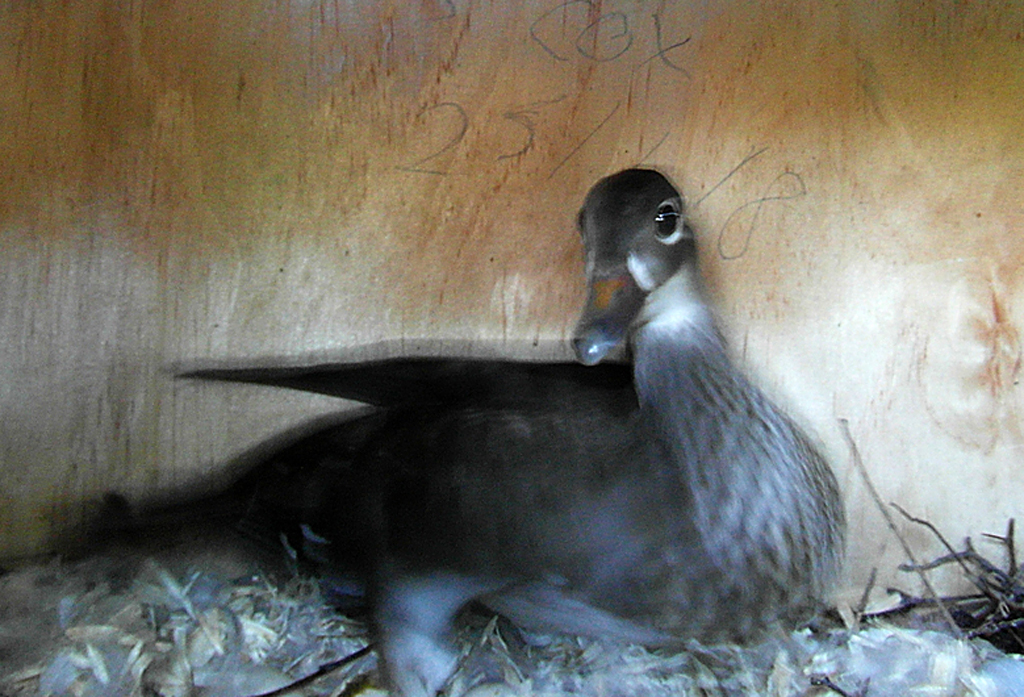
We checked it in April and could hear something moving about inside: something heavy, which didn’t sound like a Tawny Owl. Expecting a squirrel to jump out at me I opened the hatch very cautiously and was staggered to be eye to eye with a Mandarin Duck, with a clutch of nine eggs.
Mandarin Ducks naturally nest in holes in trees, and take to boxes happily. Their numbers have been increasing in our area so we were going to encounter one sooner or later but it was still a surprise!
Discovering that sometimes chicks find it difficult to get out of deep boxes we went back a couple of day later and inserted a ramp inside the boxes so the chicks would be able to climb out. They leave within a day or two of hatching, fearlessly throwing themselves out to bounce on the ground. The female will gather them up and lead them to water - Lynne Lambert
Mandarin Ducks naturally nest in holes in trees, and take to boxes happily. Their numbers have been increasing in our area so we were going to encounter one sooner or later but it was still a surprise!
Discovering that sometimes chicks find it difficult to get out of deep boxes we went back a couple of day later and inserted a ramp inside the boxes so the chicks would be able to climb out. They leave within a day or two of hatching, fearlessly throwing themselves out to bounce on the ground. The female will gather them up and lead them to water - Lynne Lambert
MK Kestrels
I first came across the Kestrel’s nest on 1st May. The nest is in a hollow of an old tree and quite open, which meant I could see the female sitting on the nest. I was lucky to find a small secluded spot where I could stand and watch without disturbing her. I would often see the male sitting on top of nearby lampposts. Sometimes he would bring food, which he would leave on a post nearby and the female would then fly out to take the food and he would take over sitting on the eggs. Crows would appear and the female would ward them off sharpish.The eggs hatched about 1st June but I didn’t get a sighting of the chicks until 3rd June. A few days later I got to see there were 4 chicks in the nest, which was great news. I saw three crows had gathered around the nest site but within minutes the male flew back and chased them away. He had been bringing back voles, Blue tits, Great tits, and Goldfinches for the family.
On 15th June I met up with BORG to get up to the nest and ring the chicks. There was still one egg unhatched, but four lovely healthy young Kestrels. Now one week later their feathers are starting to come through and the parents are feeding them regularly. Also this weekend it was incredible to watch the female warding off a Red Kite. Hopefully I will get pictures as they fledge - Roy Gray
On 15th June I met up with BORG to get up to the nest and ring the chicks. There was still one egg unhatched, but four lovely healthy young Kestrels. Now one week later their feathers are starting to come through and the parents are feeding them regularly. Also this weekend it was incredible to watch the female warding off a Red Kite. Hopefully I will get pictures as they fledge - Roy Gray
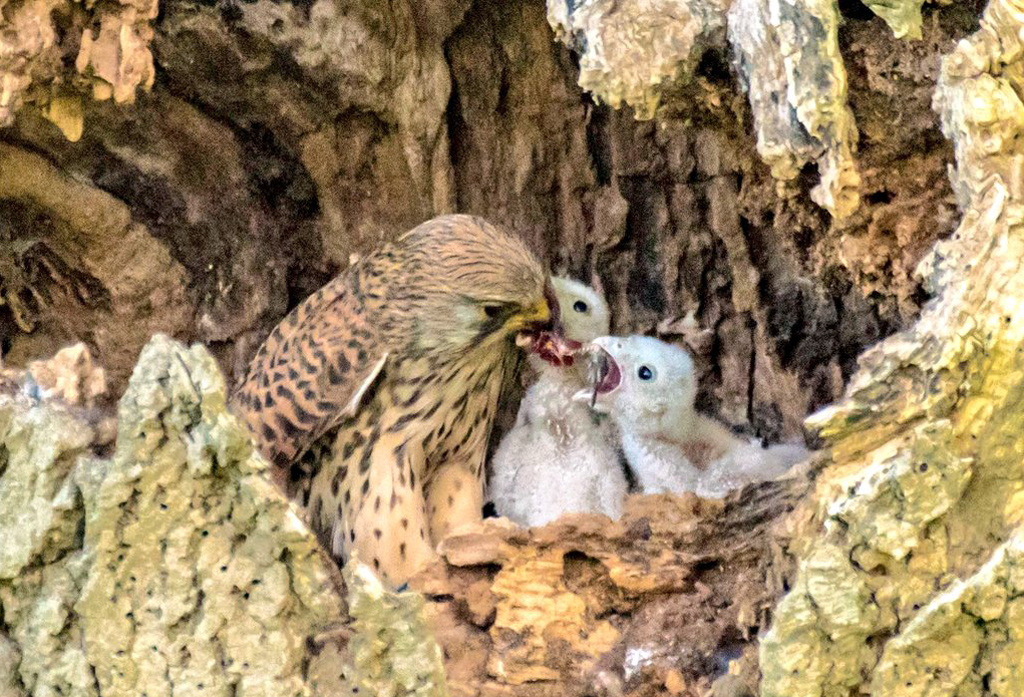
AYLESBURY PEREGRINES
BORG members have been supporting the peregrine falcons that nest on the Aylesbury County Hall building since they first were spotted there by a council employee in 2006.Peregrines choose high inaccessible cliff faces to nest, and high urban buildings will do just as well. When the young birds start to practise flying they sometimes run into trouble, and Bill and Simon from BORG have been on call to help. One year a young peregrine was spotted by a bus driver in the middle of the road; Bill and Simon were called out and they managed to retrieve the bird from the steep gully it had dropped into and return it to the nest. Another time two adult male peregrines had become locked together in combat and tangled in the netting that keeps pigeons off the building. Both birds were taken to Tiggywinkles and, while one had to be kept there for 10 weeks before release, the other bird was released the next day. Luckily the uninjured bird was the resident male and he was seen landing back on the County Hall platform literally minutes after being released. Bill and Simon are becoming experts at picking up fledging peregrines and helped get three peregrine chicks back into the nest after a call from Milton Keynes Stadium saying there were peregrines on the pitch! The young birds are not always lucky and last year’s single chick in Aylesbury was found dead below the building a few days after fledging. Still not a strong flier it was probably caught up in a strong wind and hit the building.
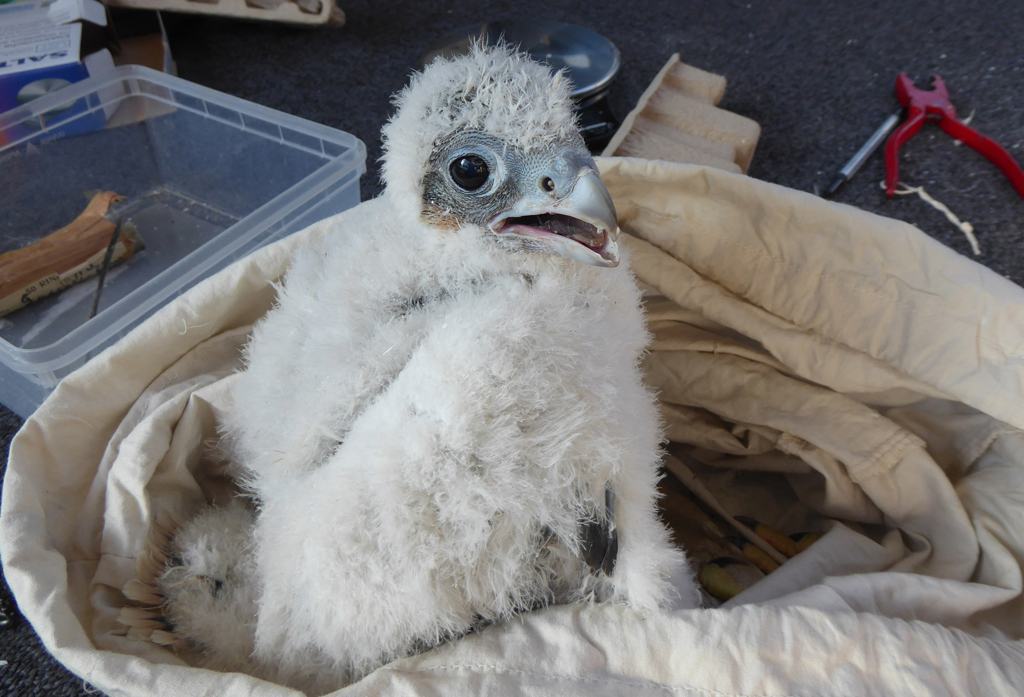
This year the Aylesbury birds have again only produced a single chick. The young bird (probably female) weighed 835g and was ringed with an orange colour ring with the letters PTH in black. Hopefully she will fledge successfully sometime at the end of June.
In mid-June, this year’s chick decided to try an early flight test, but unfortunately was not quite ready and she landed at the foot of the AVDC building. Luckily for her she was found by a member of the public who took her to Tiggywinkles and, after spending a comfortable night there, was returned to her nest by AVDC’s Biodiversity Officer and his BORG colleagues.
In mid-June, this year’s chick decided to try an early flight test, but unfortunately was not quite ready and she landed at the foot of the AVDC building. Luckily for her she was found by a member of the public who took her to Tiggywinkles and, after spending a comfortable night there, was returned to her nest by AVDC’s Biodiversity Officer and his BORG colleagues.
However, not content to try it once, two days later she tried again and this time was retrieved from the courtyard at County Hall by BORG volunteers, before again being taken to Tiggywinkles. Thankfully she did not appear to have any serious injuries and all her blood tests and x-rays were clear of problems.
Following a brief stay at Tiggy’s the young bird was released on Saturday 30th June – let’s hope she stays out of trouble this time!
BBOWT and BORG jointly run Peregrine Watch Days in Market Square in Aylesbury when we hope to show you peregrines in flight, perched on the County Hall buildings and bringing in food to the nest. Dates are advertised on the BBOWT website - Lynne Lambert & Bill Robson
Following a brief stay at Tiggy’s the young bird was released on Saturday 30th June – let’s hope she stays out of trouble this time!
BBOWT and BORG jointly run Peregrine Watch Days in Market Square in Aylesbury when we hope to show you peregrines in flight, perched on the County Hall buildings and bringing in food to the nest. Dates are advertised on the BBOWT website - Lynne Lambert & Bill Robson
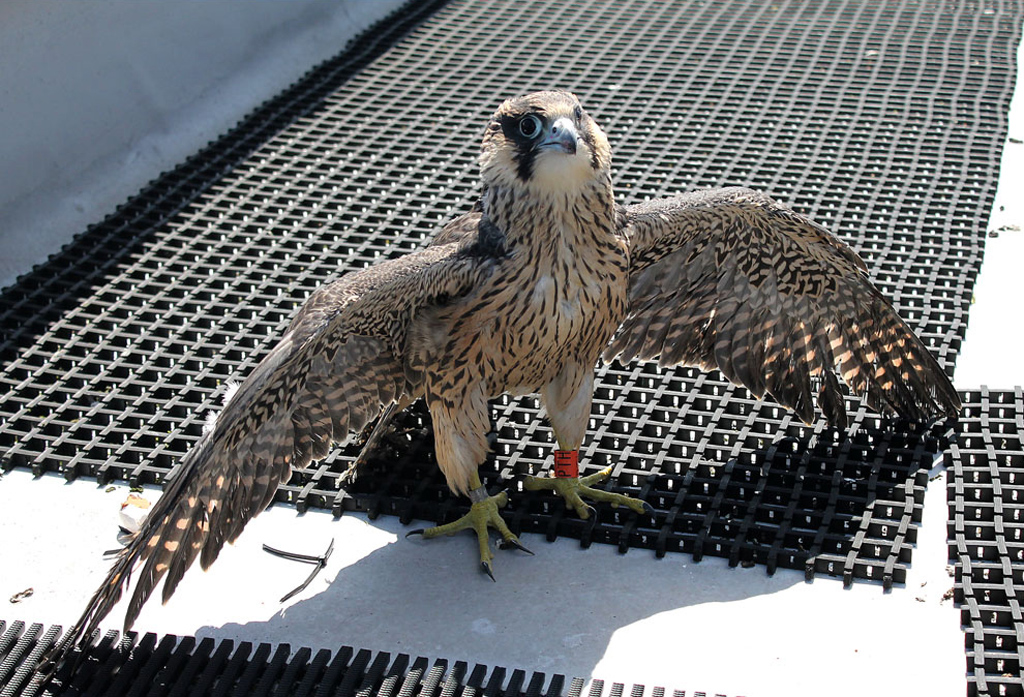
Friends of BORG
In spring 2017 we launched our new supporters’ initiative “Friends of BORG”. By becoming a Friend of BORG you are helping us to continue providing the practical conservation measures, education and research required to ensure that these charismatic birds thrive in the wild. The money generated by this scheme continues to help cover the many costs involved in running our organisation.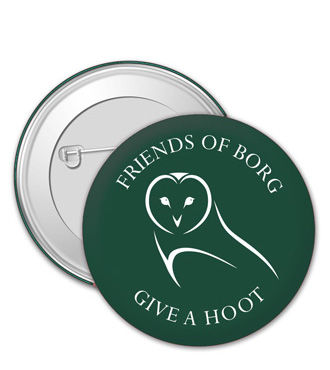
We would like to say a huge “THANK YOU” to all our current “Friends” – without you we would not be able to continue this vital work.
All our “Friends” will soon be entered into a draw to determine which of them has the opportunity to have our volunteers give a talk at a venue of their choosing. The draw will take place later this month so look out for the results in our next newsletter!
To continue our work we need more FRIENDS for information on how to become a friend of BORG please click HERE
All our “Friends” will soon be entered into a draw to determine which of them has the opportunity to have our volunteers give a talk at a venue of their choosing. The draw will take place later this month so look out for the results in our next newsletter!
To continue our work we need more FRIENDS for information on how to become a friend of BORG please click HERE
HELPING TO SUPPORT OUR WORK
We are continuously working to promote and assist owl and raptor conservation throughout Buckinghamshire, but we could not do this without the generous support of the public and businesses. We would like to say a big “Thank You” to the following for their generous support, whether that was in the form of grants, monetary donations, materials or advice and support:AVDC
Alex Engineering in Long Marston
SLG Printers in Leighton Buzzard
David Durndell
Sham & Carole Grimshaw
We would like to thank those who give support as “Friends of BORG” along with the landowners who allow us to install boxes on their property also all our volunteers for their efforts in supporting BORG. If we have missed anyone out, then we are sorry, but please be assured we do value your support as without it our work would be somewhat curtailed.
2018 EVENT DIARY
If you would like to know more about our work, or would like to meet some of our volunteers, why not come along to one of the following events and say hello…27th August – Winslow Show, Sheep Street, Winslow, Buckinghamshire, MK18 3HL
30th August – Bucks County Show, County Showground, Weedon Park, Weedon, HP22 4NN
We have other events and talks lined up for later in the year, so look out for information in your local area!
